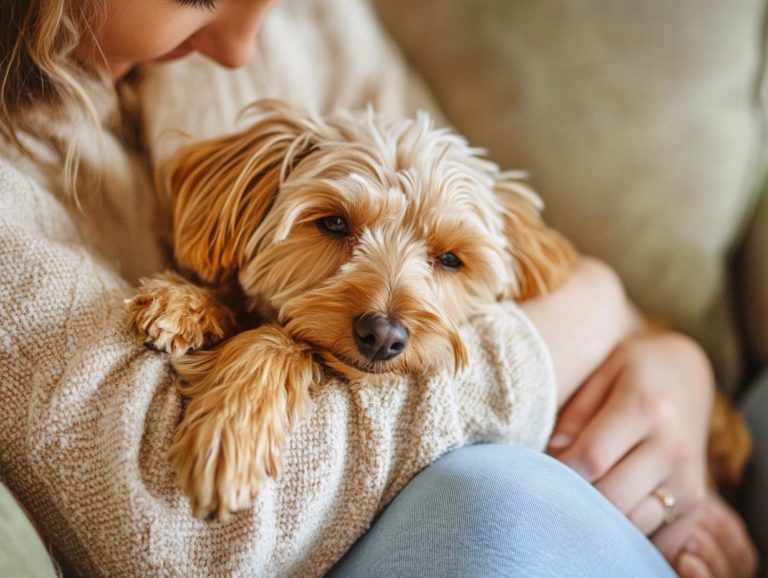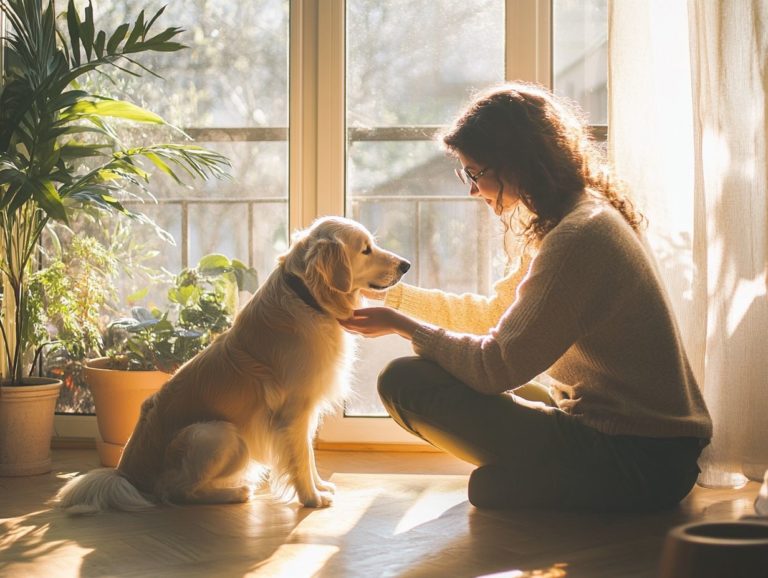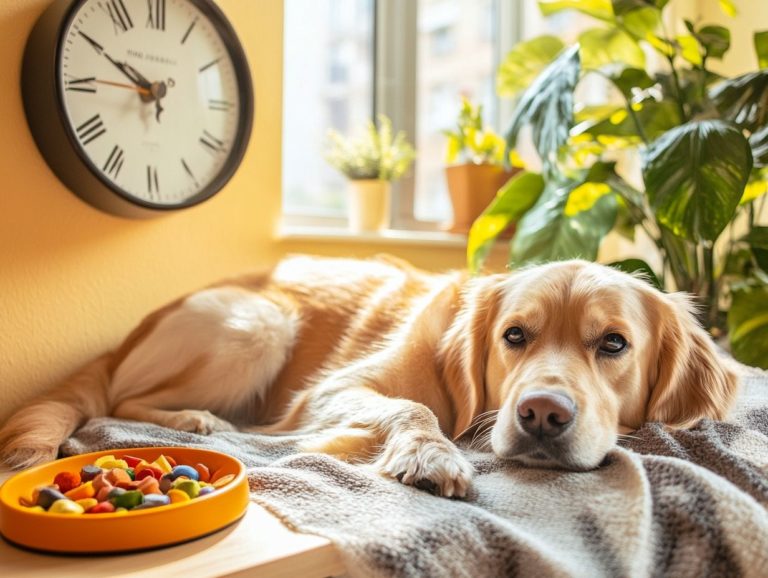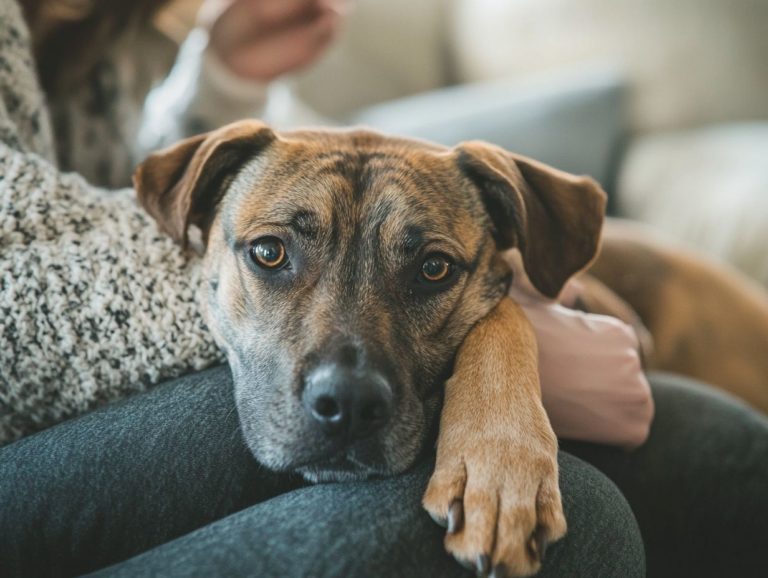How Does Weather Affect Pet Anxiety?
Pet anxiety is a prevalent issue that can profoundly affect your furry friends’ well-being, particularly during specific weather conditions.
This article delves into the various causes and symptoms of pet anxiety, focusing on how fluctuations in weather can trigger increased stress in animals.
It outlines common reactions and effective management strategies tailored to different weather patterns, along with alternative treatments and preventive measures you can implement.
By grasping these concepts, you can cultivate a more comfortable environment for your pets, ensuring their happiness and security even when the weather takes a turn.
Contents
Key Takeaways:

- Weather significantly affects your pet’s anxiety levels, causing them to exhibit symptoms like restlessness and destructive behavior.
- Common triggers for pet anxiety in different weather conditions include thunderstorms, extreme heat or cold, and changes in barometric pressure.
- To help manage pet anxiety during different weather patterns, it’s important to create a safe and comfortable environment and consider alternative treatments like natural remedies and therapies.
Understanding Pet Anxiety
As a pet owner, understanding pet anxiety is essential. Numerous factors can influence your dog’s emotional state, potentially leading to problematic behaviors that significantly impact their quality of life.
Whether the root cause is health issues like Cushing s disease a condition that affects hormone levels in dogs or hypothyroidism, or external stressors within your home, recognizing the signs is your first step toward offering the right support and care.
Being aware of the various triggers helps you take action to support your dog’s emotional well-being.
Causes and Symptoms
The causes of anxiety in dogs can be quite complex, ranging from health-related issues to various behavioral triggers. By understanding these factors, you can better identify the symptoms that might signal your pet s distress.
Take separation anxiety, for example. It often arises when dogs are left alone, manifesting in behaviors like excessive barking, destructive chewing, or constant pacing. Storm phobia is another common concern, causing dogs to tremble and seek refuge during a storm. Sudden changes in routine can also heighten anxiety levels.
Recognizing these signs early on is vital. Seeking veterinary advice is essential for accurately diagnosing the specific type of anxiety your dog may be experiencing and determining the most effective treatment options available.
Weather’s Impact on Pet Anxiety
Weather has a profound impact on pet anxiety, as the influence of environment on pet anxiety can be significant. You might notice that your dog often reacts to shifts in temperature and atmospheric conditions. This can lead to increased stress and distress, especially during storms or extreme heat.
It’s essential for you to recognize how different weather patterns can trigger anxiety in your canine companion, resulting in behavioral changes like hiding, restlessness, or excessive vocalization. If you’re wondering, is it normal for pets to have anxiety? For example, certain breeds may experience severe anxiety during rainstorms, while hot weather can heighten concerns about your dog’s safety and comfort.
Understanding these seasonal effects on your pet is crucial for ensuring their well-being.
Common Triggers and Reactions

Common triggers for anxiety in dogs include loud noises, sudden weather changes, and unfamiliar animals or people. Each dog reacts differently to these stressors.
You might notice reactions ranging from loud barking as they express their distress to seeking refuge in tight spaces, like cozying up under the bed. Some dogs may even resort to destructive behaviors, such as chewing on furniture. Fireworks are particularly notorious for causing panic, prompting dogs to try to escape or cry out in fear.
Extreme temperatures can also cause discomfort, leading them to pant excessively or seek out shady spots.
To help alleviate their anxiety, you can take several effective steps:
- Create a safe, quiet environment where they feel secure.
- You can use calming products like devices that release soothing scents for dogs.
- Gradually desensitize your pets to anxiety-inducing noises through gentle exposure.
By implementing these strategies, you have the power to create a loving space that keeps your dog calm and happy.
Managing Pet Anxiety During Different Weather Conditions
Managing your pet’s anxiety during changing weather conditions calls for a considerate strategy that caters to your dog’s unique needs and the specific environmental factors at hand. To better address these issues, it’s important to explore understanding anxiety triggers in pets. Your goal is to keep your canine companion safe and comfortable.
For instance, in hot weather, keep your furry friend cool and happy by making sure they have plenty of water and access to shaded areas. Conversely, during colder temperatures, prioritizing warmth and comfort becomes essential.
Recognizing how different weather conditions impact your dog’s emotional well-being is also important. By implementing effective strategies, you can alleviate anxiety and foster a nurturing environment for your furry friend.
Tips and Strategies for Specific Weather Patterns
To effectively alleviate anxiety in dogs during specific weather patterns, employ a variety of tips and strategies designed to foster a sense of safety and comfort for your canine companion.
Creating secure spaces where your dog can retreat during storms is essential. These areas should be equipped with familiar bedding and toys to enhance their sense of security.
Utilizing calming aids like special devices that release soothing scents for dogs or anxiety wraps can significantly reduce stress levels. Adjusting daily routines according to temperature changes is vital; for instance, opting for walks during the cooler parts of the day can prevent overheating and unease.
Keenly observing your dog’s body language such as cowering or excessive panting allows you to promptly address signs of anxiety, ensuring your furry friend feels understood and cared for during tumultuous weather.
Alternative Treatments for Pet Anxiety
Alternative treatments for pet anxiety present you with a range of options beyond traditional medication, emphasizing natural remedies and therapies that enhance your dog’s emotional well-being.
Many pet owners are increasingly turning to holistic approaches to help their dogs manage anxiety, exploring options such as herbal remedies, acupuncture, and behavioral therapies.
By consulting with a veterinary professional, you can gain valuable insights into the most effective treatments tailored to your dog’s unique needs and behaviors. This ultimately improves their quality of life and emotional stability.
Natural Remedies and Therapies
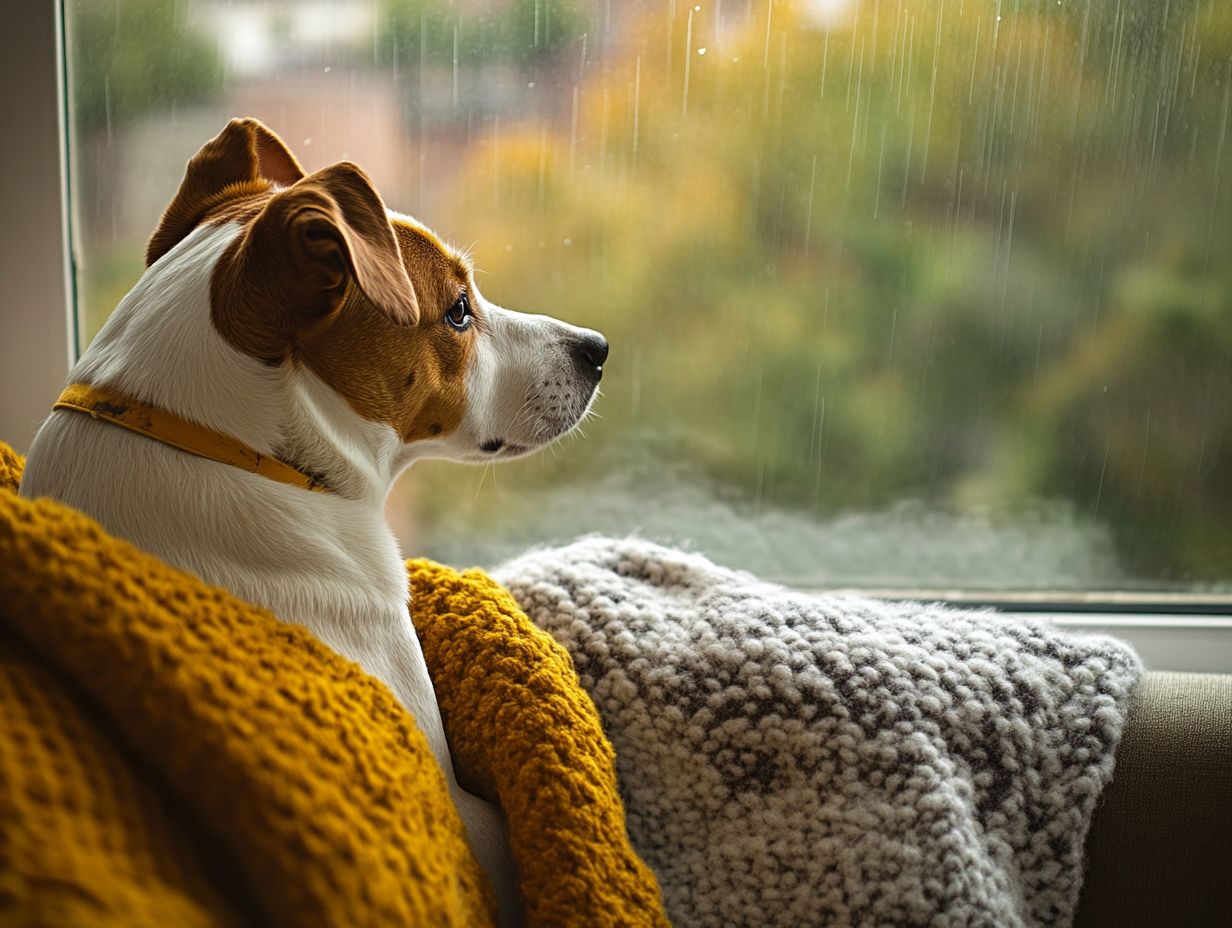
Natural remedies and therapies for dog anxiety offer effective alternatives to conventional treatments, focusing on natural and gentle methods to enhance your pet’s well-being.
Incorporating specific natural remedies, like herbal supplements such as chamomile or valerian root, can soothe your furry companion during stressful situations. Aromatherapy is also vital; using essential oils like lavender helps create a calming environment for your dog!
Using relaxation techniques can uplift your dog’s emotional state. Gentle massages or designating quiet time in a safe space can significantly improve how your dog feels. It s crucial to consult a veterinarian before choosing these therapies to ensure you select the best options and monitor your dog’s responses closely.
Creating this bond will transform your pet’s life!
Preventing Pet Anxiety Triggered by Weather
Preventing pet anxiety caused by weather conditions is essential for you as a pet owner. Additionally, understanding the effects of moving on pet anxiety can help you take proactive steps to greatly enhance your dog’s emotional resilience and overall well-being.
Recognizing specific weather factors that may trigger anxiety like thunderstorms or extreme temperatures allows you to create an environment that minimizes stressors. Establishing a cozy safe space in your home with comforting items such as toys and blankets helps your dog feel secure.
Implementing preventive strategies ensures a calmer and happier canine companion, enriching both your lives!
Creating a Safe and Comfortable Environment
Creating a safe and comfortable environment for your dog can significantly reduce anxiety and enhance emotional well-being, especially during stressful weather events.
By paying attention to your furry friend’s specific needs and preferences, you can design a sanctuary that addresses their physical comforts and resonates emotionally. Selecting a quiet corner away from disturbances provides an ideal retreat for your dog when feeling overwhelmed.
Incorporating familiar items, like their favorite blanket or toy, significantly bolsters their sense of security. Additionally, using calming products such as essential oils or soft music helps cultivate a soothing atmosphere.
Ultimately, understanding your dog’s individual preferences whether they crave space or closeness is crucial for shaping a personalized comfort zone that nurtures their sense of safety and well-being.
Frequently Asked Questions
How does weather affect pet anxiety?
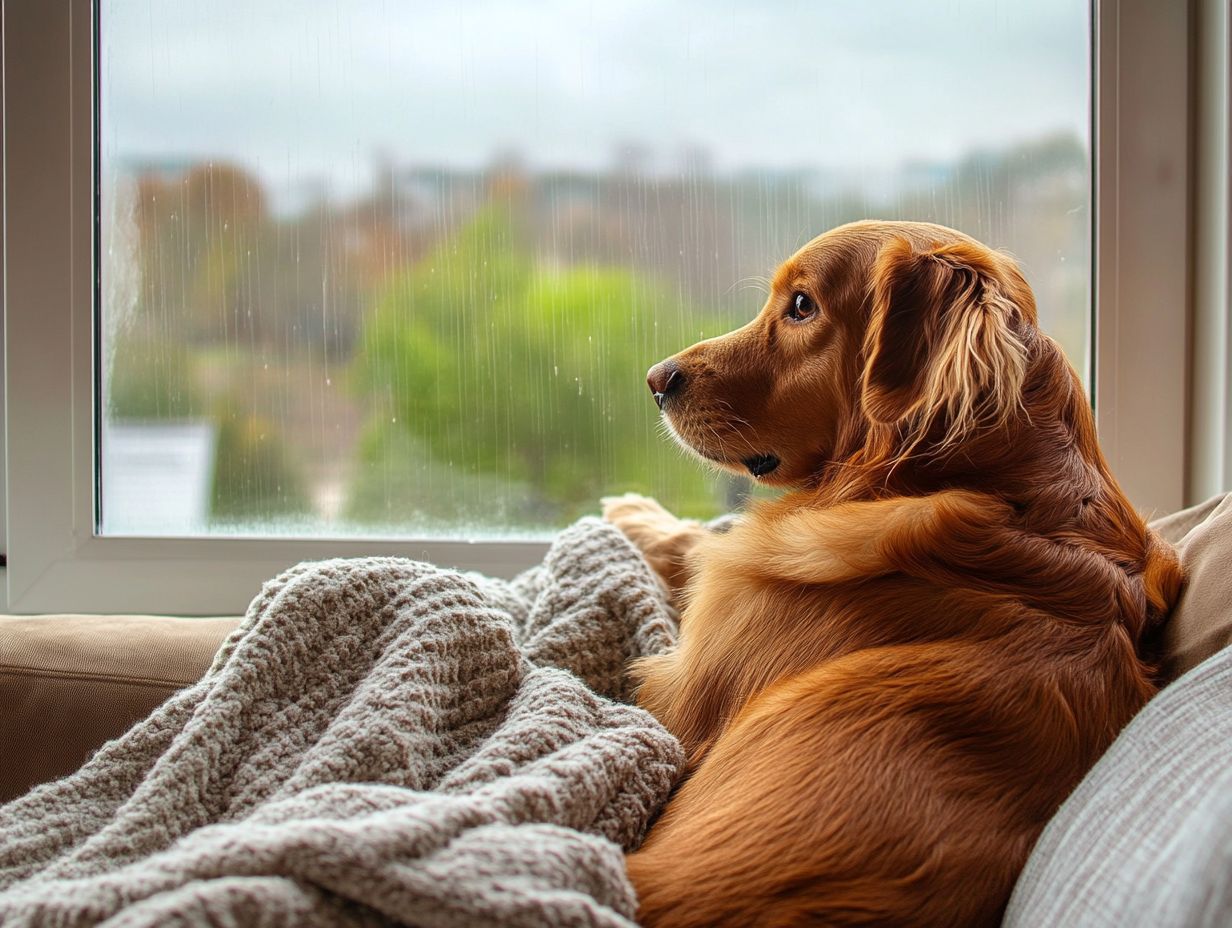
Weather can significantly impact pet anxiety. Just like humans, pets can experience mood and behavior changes due to weather variations, making it important to understand temperature’s role in pet anxiety.
What types of weather can trigger pet anxiety?
Thunderstorms, high winds, extreme heat or cold, and changes in barometric pressure are common weather conditions that can trigger pet anxiety during thunderstorms.
How do thunderstorms affect pet anxiety?
Thunderstorms can be stressful for pets due to loud noises and flashing lights. Sudden changes in atmospheric pressure can also cause discomfort for pets.
Why does my pet become anxious during extreme temperatures?
Extreme heat or cold can be uncomfortable and even dangerous for pets. This discomfort can lead to increased anxiety and restlessness.
Can changes in weather cause separation anxiety in pets?
Yes, pets may experience separation anxiety when their owners leave during changes in weather. The change in routine and environment can cause stress and anxiety for pets, especially during the holidays, so it’s important to explore understanding pet anxiety during the holiday season.
There are several things you can do to help your pet cope with weather-related anxiety. Providing a safe and comfortable space, using calming techniques like music or pheromone sprays, and learning how to identify the triggers of your pet’s anxiety can also be beneficial. Additionally, consult a veterinarian for further support!

